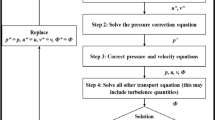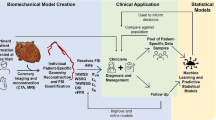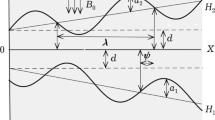Abstract
In this study, a fluid-structure interaction (FSI) simulation of the blood flow in the femoral artery with a small occlusion is presented. For a more accurate simulation of the real conditions, computerized tomography (CT) scan was used to obtain a 3-D model of leg blood vessels, while the vessel was modeled as an isotropic elastic wall. By assuming a heartbeat period of 0.5 s, the inlet condition was considered as a time-dependent pulse using a non-Newtonian flow model. Blood flow was assumed nonlinear and incompressible, and Carreau model was used for blood rheological model.
By considering unstable blood flow at the inlet, the involved hemodynamic parameters are velocity profile, vortices shapes, pressure drop, and streamlines. Furthermore, to determine the relationship between flow geometry and the vascular wall, wall shear stress (WSS) was calculated.
By taking the real geometry of the vessel and fluidity of blood into account, comparison of computational results indicated a significant difference in velocity distribution and shear stress depending on whether the fluid-structure interaction is considered Newtonian or non-Newtonian. The results showed that employing Newtonian models for the blood flow does not lead to promising results at occluded areas and beyond them.












Similar content being viewed by others
Abbreviations
- X, Y, Z:
-
Coordinates
- Uf :
-
Velocity vector (m/s)
- ρf :
-
Blood density (kg/m3)
- σ f :
-
Stress tensor
- p :
-
Blood pressure (Pa)
- I :
-
Identity matrix
- \( {\eta}_f\left(\dot{\gamma}\right) \) :
-
Blood viscosity (Ns/m2)
- \( \dot{\gamma} \) :
-
Shear strain
- η 0 f :
-
Zero strain viscosity (Pa. s)
- η ∞ f :
-
Infinite strain viscosity (Pa. s)
- n :
-
Empirical exponent
- λ f :
-
Time constant (s)
- E :
-
Young module (N/m2)
- ν :
-
Poisson ratio
- ρ s :
-
Artery density (kg/m3)
- L s :
-
Artery wall displacement (m)
- \( {d}_i^f \) :
-
Fluid displacement at FSI (m)
- \( {d}_i^s \) :
-
Artery displacement at FSI (m)
- m :
-
Normal vector at FSI
- t :
-
Time (s)
References
Heart disease and stroke statistics, American Heart Association, published online ahead of print 2014, Dallas, Texas, USA
ECDS (2016) British Heart Foundation of Health Promotion Research Group, http://www.heartstats.org/
2016 Everyday Health Media, LLC (2016) http://www.everydayhealth.com/
American Heart Association (2016). http://www.heart.org/
Haghighi AR, Asadi Chalak S (2016) A non-Newtonian model of pulsatile blood flow through elastic artery with overlapping stenosis. Modarres Mechanical Engineering 16(3):232–238
Young DF (1968) dependent stenosis on flow through a -Effect of a time tube. Journal of Engineering for Industry 90(2):248–254
Lee J, Fung Y (1970) Flow in locally constricted tube at low Reynolds number. J Appl Mech 37(1):379–416
Morgan BE, Young DF (1974) An integral method for the analysis of flow in arterial stenosis. Bull Math Biol 36(1):39–53
Azuma T, Fukushima T (1976) Flow patterns in stenotic blood vessel models. Biorheology 13(6):337–355
Liu GT, Wang XJ, Ai BQ, Liu LG (2004) Numerical study of pulsating flow through a tapered artery with stenosis. Chin J Phys 42(4):401–409
Yamaguchi N (2005) Existence of global strong solution to the micropolar fluid system in a bounded domain. Mathematical Methods in the Applied Sciences 28(13):1507–1526
Cho YI, Kensey KR (1991) Effects of the non-Newtonian viscosity of blood on hemodynamic of diseased arterial flows: Part 1. Biorheolgy 28(3–4):241–262
Mandel PK (2005) An unsteady analysis of non-Newtonian blood flow through tapered arteries with a stenosis. International Journal of Non-Linear Mechanics 40(1):151–164
Obidowski D, Jozwik K (2010) Numerical simulation of the blood flow through vertebral arteries. J Biomech 43:177–185
Wang Y, Xie X, Zhou H (2013) Impact of coronary tortuosity on coronary blood flow: A 3D computational study. J Biomech 46:1833–1841
Jalali P, karimi S, Dabagh M, Vasava P, Dadvar M, Dabir B (2014) Effect of rheological models on the hemodynamics within human aorta: CFD study on CT image-based geometry. J Non-Newtonian Fluid Mech 207:42–52
Barrett KE, Barman SM, Boitano S, Brooks H (2015) Ganong's Review of medical physiology, 24th Edition (LANGE Basic Science), California, ISBN-13: 978–0071780032
Razavi A, Shirani E, Sadeghi MR (2011) Numerical simulation of blood pulsatile flow in a stenosed carotid artery using different rheological models. J Biomech 44:2021–2030
Sinnott MD, Cleary PW, Prakash M (2006), An investigation of pulsatile blood flow in a bifurcating artery using a grid-free method, Fifth International Conference on CFD in the Process Industries CSIRO, Melbourne, Australia
Chan WY (2007) Modeling of non-Newtonian blood flow through a stenosed artery incorporating fluid-structure interaction. ANZIAM J 47:507–523
Abdollahzadeh Jamalabadi MY, Daqiqshirazi M, Nasiri H, Safaei MR, Nguyen TK (2018) Modeling and analysis of biomagnetic blood Carreau fluid flow through a stenosis artery with magnetic heat transfer: A transient study. PLoS One 13(2):e0192138
Fry DL (1968) Acute vascular endothelial changes associated with increased blood velocity gradients. Circ Res 22:165–197
Ramstack JM, Zuckerman L, Mockros LF (1979) Shear induced activation of platelets. J Biomech 12:113–125
Author information
Authors and Affiliations
Corresponding author
Ethics declarations
Conflicts of interest
The authors declare that there is no conflict of interest or funding resource regarding the publication of this paper.
Additional information
Publisher’s note
Springer Nature remains neutral with regard to jurisdictional claims in published maps and institutional affiliations.
Rights and permissions
About this article
Cite this article
Amiri, M.H., Keshavarzi, A., Karimipour, A. et al. A 3-D numerical simulation of non-Newtonian blood flow through femoral artery bifurcation with a moderate arteriosclerosis: investigating Newtonian/non-Newtonian flow and its effects on elastic vessel walls. Heat Mass Transfer 55, 2037–2047 (2019). https://doi.org/10.1007/s00231-019-02583-4
Received:
Accepted:
Published:
Issue Date:
DOI: https://doi.org/10.1007/s00231-019-02583-4




